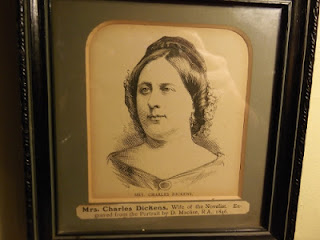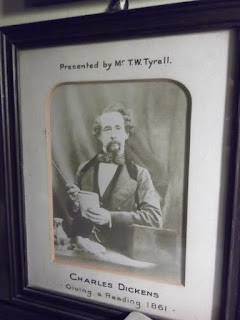Were the medieval family brasses in Cobham Church and “The Leather Bottle” Inn, secret sources of inspiration for Charles Dickens?
We undertook a short “Charles Dickens” literary tour today, after attending Rochester Cathedral, this morning. First, we located the house that Dickens moved to, after separating from his wife, Catherine. Here he lived "scandalously" with his sister-in-law, Georgiana, and some of his daughters. I recently located the grave of two of these daughters in the churchyard of St Nicholas, Sevenoaks. They clearly moved away after Dickens died. Unlike their father, the children did not grow up in Chatham, as he had, just down the hill from this house, on the Thames Estuary.
Gad's Hill Place, Higham
Charles Dickens' last house was called "Gad’s Hill Place" in Higham, Kent. This very hill or even the same plot is also the scene of Falstaff and fellows' highway robbery in Shakespeare's "Henry IV" - a fact that Dickens revelled in. This house is where a prematurely aged Dickens collapsed and died in his fifties. In modern terms, the house is nothing much too look at. As you can see (below), it might belong to a wealthy company director or accountant.
So why did the most successful author of Victorian England buy it? Well, one reason may be that this was the house that his father pointed out to him, as a boy, as being a suitable house for a successful son.
Higham today is a rather less attractive place than when Charles Dickens moved there. St John’s Parish Church which Dickens sometimes attended on Sundays, is no longer a mile's walk down a pleasant country lane.
The real advantage of Higham seems to be its proximity to the train to Charing Cross, London. It was also within walking distance of Rochester and its lovely Norman Cathedral, where Dickens specifically asked to be buried. I often lament, while in the Cathedral, that his wishes were over-ruled and that he was buried in Poets' Corner, Westminster Abbey - when his heart was clearly in Kent. Dickens was a “walkaholic” so walking into Rochester was just a stroll for him. Norman Rochester Cathedral inspired “The Mystery of Edwin Drood”.
However, after our tour today, I am beginning to wonder whether the real reason that Dickens moved to Higham was to be close to Cobham, which was a Sunday morning's walk away.
Cobham is a very picturesque village, with a famous pub and Church which I now believe could have been a major source of inspiration for Dickens, all his life. I will return to this topic, in a moment.
I know where Dickens' house “Gad’s Hill Place” is for one reason. Some years ago, I attended the annual Christmas Dickens Festival in Rochester. There is only one day a year when one can take a minibus from Rochester and access the house, which is now a private school. There is no signpost or sign in Higham saying "Charles Dickens lived here". There are no blue plaques and, for me, most heartbreakingly, the inspirational plot of land, over the road from the house, where his wrote in his Swiss chalet, has almost fallen prey to developers (photo below).
This is all that now remains of piece of garden, over the road, that Dickens owned. In it, was space for the Swiss chalet, now in the High Street in Rochester.There is no plaque telling you that this plot is almost “sacred” - for the Victorian novel. He wrote his greatest book “Great Expectations” here - and also his last novel, “The Mystery of Edwin Drood”.
There is the tunnel under the road which Dickens had built. We found it today, almost neglected. One could go down to it, but there is debris piling up, which deters one from venturing through.
There is nothing to tell you that the “mask” over the tunnel (below) is the mask of “tragedy” and that it was placed there by Dickens himself. I did not fancy going through it as you can see....debris.
Cobham
We then drove three to four miles into beautiful country of the North Downs to the village of Cobham. Owletts (National Trust) is here, as well a huge Elizabethan mansion, Cobham Hall (now a school). It was in its grounds Charles Dickens took his last walk.
I think one source of Dickensian influence may come from St Mary Magdalene Church, Cobham, famous for its medieval de Cobham family brasses.
Cobham Parish Church
The twenty or so brasses show individual members of the medieval de Cobham family, from the 14th century onwards, all beautifully dressed in the high fashion of medieval times. They are all “personalities” in their own right. The ladies are amazingly sleek, in slim 1930's type "evening dresses” and wimples. The knights wear highly shaped, stylish armour. These “family” brasses fully preserve all those personalities. For some photos of the brasses see:
Across from the church is Charles Dickens favourite watering hole, "The Leather Bottle", which is also a incomparable “shrine” to the writer (below).
The Leather Bottle, Cobham
Dickens wrote parts of “The Pickwick Papers” at this Inn so he clearly found it inspirational. The Pickwick Papers is a book full of personalities and portraits, conveying the warmth of an 18th coaching inn, a sense of which overwhelms one, once inside the building. Mr Pickwick himself commends Cobham as a perfect village, in the novel.
I really believe that this inn is the platonic version of every warm English coaching inn in Dickens' works. It offers history, stability, robust "Englishness", larger than life characters in the rooms, and on the walls. It radiates good humour, warmth and bonhomie, as these photos show. The good English food is equally uplifting! There is something healing about its ancient timbers.
Its walls are covered with portraits of Dickens, with a beard and without a beard (below)
There is a fine print of Mrs Dickens (below) and also collections of Dickens’ many imagined personalities. The "personalities" mirror the brasses in the church, each with its own distinctive costume and enduring history.
I had the honour of sitting next the the huge black leather bag for £40 of heavy silver (currency) carried on Dickens first speaking tour (“the funds”) and also an almost completely invisible strand of his hair, framed (below).
“The Leather Bottle” is a true Dickens shrine, with the added attraction of being not only loved by his many fans, but by Mr Pickwick - and the author himself.
We also had his books all round us at lunch. I read the start of “Great Expectations” aloud and my husband used the title as a “meaningful” photo for his Facebook site. Mr Pickwick seems to be sitting behind him!
Suddenly, something struck me while looking at this lovely illustration (below), above our table - showing a bewildered and insecure little boy with an over optimistic but "financially challenged" father. I was also aware of the print of Dickens' vulnerable and sensitive face (above) under his beard. I realised why Dickens may have loved “The Leather Bottle” so much, all his life:
Surely what Charles Dickens pined for was: happy families, security and the obliteration of the memories of debtors' prison, where his father ended up.
Where better place to dream of stability and security than in The Leather Bottle, Cobham surrounded by enduring “personalities”, real and historical, from every age?
References
See pp 75 onwards in "The Inns and Taverns of Pickwick". The "Leather Bottle" was a magnet for Charles Dickens, all his life. He took friends there and on the local walks and basically clearly treated it, Cobham Hall and Cobham village, as his private "refuge".

















Lovely. As a tiny postscript to this I am going to post something on my Preston blog on Linked-In (if it is still there) on Dickens and Preston. Dickens visited here in the midst of the 1854 cotton workers strike and observed the orderly and dignified conduct of the strikers which he depicted in "Hard Times" . The book is a parable on the futility of Utilitarianism as a moral and political guide to life.
ReplyDelete